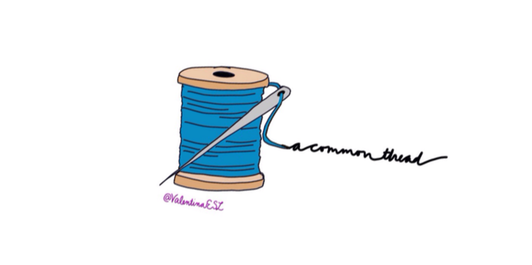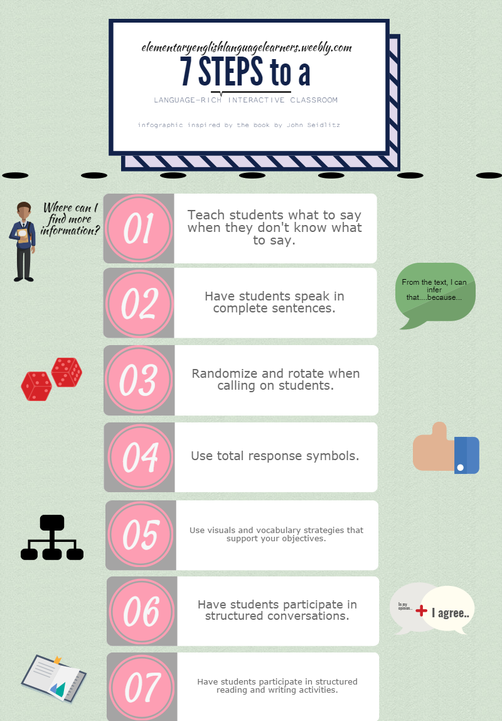|
Systemic, campus-wide change…if that’s what you are looking for, this may be the answer for you.
I’ve often heard that campus leaders are looking for “a common thread that binds the campus”… “a thread that weaves naturally through pre-K to 5th grade in all classrooms”. Here’s how we successfully accomplished just that in our district in Texas. Recently, I read a book that I found practical and relevant to all grade levels and content areas. The book is called 7 Steps to a Language-Rich Interactive Classroom by John Seidlitz and Bill Perryman. I loved that it was research based and reader friendly. I decided to make this book into a hybrid online and face-to-face book study that campuses in my district could use. (But you can use any book that you feel is relevant to the needs of your campus.)
In our district, we use Canvas to create online courses and classes not only for teachers but also for students. Canvas is a platform for online learning much like Blackboard for those of you who might be familiar with that from college courses. So I created a Canvas Course/Book Study for 7 Steps to a Language-Rich Interactive Classroom.
Basically, teachers read a chapter of the book, implement their learning in their classrooms, and then discuss the learning in the online Canvas course. 3 easy steps. Since this is not a typical book study, I found that giving 3 easy steps helps teachers understand the structure. Once the course was created, we targeted specific campuses in a number of ways. We either looked at need based on data or on administrative support. We knew that if we had a campus that would willingly participate in this unique professional development then the chances of success would be greater. After meeting with administrators from the campus, we came up with a time line together for completion of the course. We also added in either teacher coaching or classroom demonstrations depending on campus need. Teacher coaching is best for campuses where the teachers have more experience in the 7 Steps and wanted us to come in, observe teachers and give feedback. Whereas classroom demonstrations best meets the needs of campuses that have less experience with the 7 Steps. Classroom demonstrations are actually my favorite part. During teachers' planning period, they have an opportunity to observe a classroom demonstration lesson that incorporates the 7 steps. Debriefing follows the demonstration. We worked with campus leaders to develop a rotating schedule for the entire day in order for all teachers to have an opportunity to observe a lesson in a grade level close to their own. For example, first grade teachers came to observe a lesson in a second grade classroom and second grade teachers observed in third grade and so on. Another facet of our professional development was face to face training. We coordinated with the campus tailor our face to face training so they meet the direct needs of the campus. On some campuses, it was decided that we brought in Seidlitz Education (see link here), the authors of the book we read, while on others, we came in and worked with teachers to help them create sentence stems that support students at varied language levels, we targeted structured conversations, or structured writing. Many factors contributed to the success of this unique type of professional development:
The beauty is that it continues to evolve. It has not ended. We are still visiting with the school we first started doing this with over a year ago. We continue the learning journey with these teachers. In fact, we recently held a Twitter Chat specifically about this book and invited the campuses that have participated in the Canvas Course/Book Study. The turnout was amazing! And the learning continues. In addition, we have even partook in a district wide Learning Walk at one of the campuses that participated in the Canvas Course Book Study. Leaders from around the district came to observe several classrooms to see the language rich environment that has been fostered at the campus. The pride and excitement that I saw in these teachers and the principal of the campus was beautiful. Something magical happened here. It was systematic change. For the campus, the benefits are so great! Not only do their current students benefit from the learning their teachers have implemented, but because EVERY teacher on campus is speaking a common language, the following year students are hearing THE SAME language from their new teachers. This common language that the teachers have embraced because of the online book study, demonstrations, coaching, twitter chats, learning walks, etc. continues to increase the success of the students at the campus. Have you found a unique way to provide professional development or create systematic change on a campus? Please share with us. Below is an info-graphic about the book that we used for the Canvas Course Book Study discussed above. I highly recommend this book. It's relevant for grades k-12.
Tan
3/16/2017 09:20:34 am
Nice post, Valentina. What a great idea to get teqchwrs reading the same thing, so they can talk about the same thing: how to raise stident avhievement. Great idea to build relationships.
Valentina Gonzalez
3/16/2017 09:24:39 am
Tan, I can't tell you how powerful it has proven to be. It's more than just reading the same book. The small steps of reading, implementing, and discussing online. Then adding in some face to face PD...it's been a great transformation. Thanks for reading. 3/28/2017 10:22:26 am
I'm so glad your district has had such success with the 7 Steps. I always love coming out to Katy! And so does my entire team. A systemic approach is the only way to get lasting change. - John Seidlitz 3/28/2017 06:48:57 pm
John, thank you for stopping by my blog. I am honored that you visited. Much of what I write about is based on my readings from your books or presentations. Thank you for everything! We LOVE you and the Seidlitz team.
Alyson Esch
11/15/2017 08:08:49 pm
I tried implementing this book (which I LOVE) with my staff a while ago, but people seem so resistant to change ... except I don’t see it as change. It’s a book of best practices, really ... stuff you probably already do. It’s all about being more intentional in your teaching.
Amy Keane
10/25/2019 03:41:31 pm
I also use Canvas. Can you share the book study course with me? My campus is reading the book now and I would be interested to see you Canvas course.
Gina Daigle
12/5/2019 01:25:20 pm
Hello. We are wanting to implement this text with our teachers. WE have some great ones, yet we always wanting to showcase and do more.
Valentina
12/6/2019 08:53:38 am
Hi Gina,
Wendy
10/12/2021 11:33:41 am
I would also love to see the book study course. I am creating one now, and am interested in seeing the timeline and what was done online vs. in person. Thanks! Comments are closed.
|
Categories
All
|



 RSS Feed
RSS Feed
